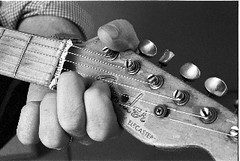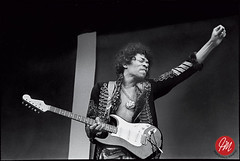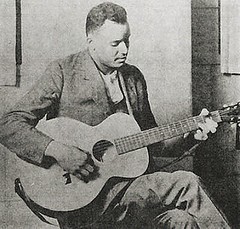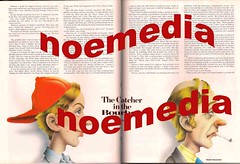I got a call from Roy's nephew the other day, after he bought my DVD. He has posted some cool video about Roy here and here.
If you want a little taste of the DVD – a try before you buy, if you will – just go here.
Thanks for the tip o the hat. When I interviewed Marty Scorsese last year in the Hollywood Reporter, he was all about paying tribute to Roy (and Roy's protege Robbie Robertson) when he used "Sweet Dreams" for the soundtrack of "The Departed," that little old movie he made in Boston with Jack and Leo ...
www.youtube.com/watch?v=rDDVf1AhNPY
By Noë Gold Doctor Noe is a veteran cultural commentator, former Features Editor at the Hollywood Reporter and Founding Editor of Guitar World. For the complete interview of Frank Zappa by Noë Gold for Guitar World, go to http://wiki.killuglyradio.com/wiki/Zappa%27s_Inferno
Wednesday, May 12, 2010
Thursday, March 25, 2010
Jim Marshall R.I.P.
“This shot of Jimi was taken during a soundcheck at the Monterey Pop Festival, 1967. Jimi was playing to an empty arena — or, more accurately, to himself. I was one of the official photographers and, for some reason, everyone was at dinner except Al Kooper, Jimi's band and crew, and some of the other stage hands. I approached Jimi and told him my name was Jim Marshall — that I was one of the photographers. He made some comment like, 'Far out, man, maybe this shit is supposed to be,' and I asked what he meant. He said the dude who made his amps was named Jim Marshall, and smart-ass me says, 'Yeah, I know that.' But then he said, 'What you don't know is that my middle name is Marshall.' We were all pretty stoned (the amp Marshall wasn't there), but there were three Marshalls onstage at once.”
—Jim Marshall
—Jim Marshall
Monday, March 15, 2010
Jerry Seidenfeld at Newport '65 by Dave Gahr
He's sleeping it off the day after we saw Dylan go electric!
I was there too, at Newport '65. My buddy Jerry Seidenfeld is sleeping it off on a cot on page 20 of Dave Gahr's "Festival Songbook" (a whole drawerful of Dylan prints Dave gave me were stolen from my garage in Santa Monica years later.)
True dat about the crowd reaction. From where I was standing (in the rear) I thought they were all yelling, "Down in front!"
To quote Dylan, "There was magic in the air."
I was there too, at Newport '65. My buddy Jerry Seidenfeld is sleeping it off on a cot on page 20 of Dave Gahr's "Festival Songbook" (a whole drawerful of Dylan prints Dave gave me were stolen from my garage in Santa Monica years later.)
True dat about the crowd reaction. From where I was standing (in the rear) I thought they were all yelling, "Down in front!"
To quote Dylan, "There was magic in the air."
Labels: directors, comedy, desserts, Yiddish,
"Bob Dylan",
"Newport 1965",
historic,
outrageous,
spectacular,
Zimmy
Tuesday, March 9, 2010
Scrapper Blackwell
Someone ought to submit Scrapper's story to Unsolved Crimes ...
In 1962, he was ready to resume his blues career when he was shot and killed during a mugging in an Indianapolis alley. He was 59 years old. Although the crime remains unsolved, police arrested his neighbor at the time for the murder. Blackwell is buried in New Crown Cemetery, Indianapolis.
Scrapper Blackwell (February 21, 1903 – October 7, 1962) was an American blues guitarist and singer; best known as half of the guitar-piano duo he formed with Leroy Carr in the late 1920s and early 1930s, he was an acoustic single-note picker in the Chicago blues and Piedmont blues style, with some critics noting that he veered towards jazz.
Kokomo Blues
Scrapper Blackwell also made solo recordings for Vocalion, including "Kokomo Blues" which was transformed into "Old Kokomo Blues" by Kokomo Arnold before being redone as "Sweet Home Chicago" by Robert Johnson.
www.youtube.com/watch?v=2CZEGJfes1c
In 1962, he was ready to resume his blues career when he was shot and killed during a mugging in an Indianapolis alley. He was 59 years old. Although the crime remains unsolved, police arrested his neighbor at the time for the murder. Blackwell is buried in New Crown Cemetery, Indianapolis.
Scrapper Blackwell (February 21, 1903 – October 7, 1962) was an American blues guitarist and singer; best known as half of the guitar-piano duo he formed with Leroy Carr in the late 1920s and early 1930s, he was an acoustic single-note picker in the Chicago blues and Piedmont blues style, with some critics noting that he veered towards jazz.
Kokomo Blues
Scrapper Blackwell also made solo recordings for Vocalion, including "Kokomo Blues" which was transformed into "Old Kokomo Blues" by Kokomo Arnold before being redone as "Sweet Home Chicago" by Robert Johnson.
www.youtube.com/watch?v=2CZEGJfes1c
Monday, February 15, 2010
"The Catcher in the Bourbon," a parody
I edited this story back in 1974, and commissioned the art, etc. Our little publication was only limited to two highly collectible issues and was seen by not many people, but some of the things in this issue especially are memorable and – it turns out, highly prescient.
This parody of "Catcher" by Bill Majeski is a case in point. And then there is the cover story by Nat Hentoff on Lenny Bruce and a nice article on Miles Davis, bebop and new jazz by moi.
I've created a deluxe limited edition, signed and numbered, of this Salinger tribute. It's a collector's edition, based on a facsimile of the original, printed on TWO SHEETS OF 11" x 17" PREMIUM CARD STOCK.
Please contact me at noemedia@pacbell.net and I will send you info on how to get one.
This is a parody published by College Monthly October 1974.
© 2010 noemedia.
© 1974. All rights reserved under international conventions. No material may be reproduced without written permission of the publisher.
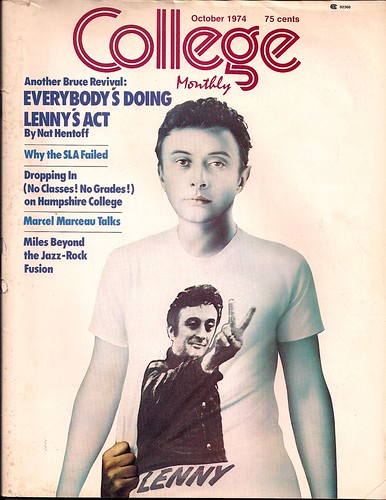
Cover photo by Basil Pao
With retouching by Rainbow Graphics, body by Doug, hand by Noë of New York. T-shirt by Harry Gross; photo by UPI, lighting by Chris Callis, and body English by Tom King.
This parody of "Catcher" by Bill Majeski is a case in point. And then there is the cover story by Nat Hentoff on Lenny Bruce and a nice article on Miles Davis, bebop and new jazz by moi.
I've created a deluxe limited edition, signed and numbered, of this Salinger tribute. It's a collector's edition, based on a facsimile of the original, printed on TWO SHEETS OF 11" x 17" PREMIUM CARD STOCK.
Please contact me at noemedia@pacbell.net and I will send you info on how to get one.
This is a parody published by College Monthly October 1974.
© 2010 noemedia.
© 1974. All rights reserved under international conventions. No material may be reproduced without written permission of the publisher.

Cover photo by Basil Pao
With retouching by Rainbow Graphics, body by Doug, hand by Noë of New York. T-shirt by Harry Gross; photo by UPI, lighting by Chris Callis, and body English by Tom King.
J.D. Salinger R.I.P.
This excellent essay is from The New Yorker. February 8, 2010.
www.newyorker.com/talk/2010/02/08/100208ta_talk_gopnik
Postscript
J. D. Salinger
by Adam Gopnik
J. D. Salinger’s long silence, and his withdrawal from the world, attracted more than the usual degree of gossip and resentment—as though we readers were somehow owed more than his words, were somehow owed his personal, talk-show presence, too—and fed the myth of the author as homespun religious mystic. Yet though he may seem to have chosen a hermit’s life, Salinger was no hermit on the page. And so his death throws us back from the myth to the magical world of his writing as it really is, with its matchless comedy, its ear for American speech, its contagious ardor and incomparable charm. Salinger’s voice—which illuminated and enlivened these pages for two decades—remade American writing in the fifties and sixties in a way that no one had since Hemingway. (The juvenilia of most American writers since bear the mark of one or the other.) But if it had been Hemingway’s role to make American writing hardboiled, it was Salinger’s to let it be soft, even runny, again. ....
And this just in ...
Salinger and Lennon: A Fatal Distraction
Posted by Simon Warner
on Rock's Back Pages
www.rocksbackpagesblogs.com/2010/01/salinger-and-lennon-a...
www.newyorker.com/talk/2010/02/08/100208ta_talk_gopnik
Postscript
J. D. Salinger
by Adam Gopnik
J. D. Salinger’s long silence, and his withdrawal from the world, attracted more than the usual degree of gossip and resentment—as though we readers were somehow owed more than his words, were somehow owed his personal, talk-show presence, too—and fed the myth of the author as homespun religious mystic. Yet though he may seem to have chosen a hermit’s life, Salinger was no hermit on the page. And so his death throws us back from the myth to the magical world of his writing as it really is, with its matchless comedy, its ear for American speech, its contagious ardor and incomparable charm. Salinger’s voice—which illuminated and enlivened these pages for two decades—remade American writing in the fifties and sixties in a way that no one had since Hemingway. (The juvenilia of most American writers since bear the mark of one or the other.) But if it had been Hemingway’s role to make American writing hardboiled, it was Salinger’s to let it be soft, even runny, again. ....
And this just in ...
Salinger and Lennon: A Fatal Distraction
Posted by Simon Warner
on Rock's Back Pages
www.rocksbackpagesblogs.com/2010/01/salinger-and-lennon-a...
Saturday, February 6, 2010
Jerry Seidenfeld at Newport '65 by Dave Gahr

I was there too, at Newport '65. My buddy Jerry Seidenfeld is sleeping it off on a cot on page 20 of Dave Gahr's "Festival Songbook" (a whole drawerful of Dylan prints Dave gave me were stolen from my garage in Santa Monica years later.)
True dat about the crowd reaction. From where I was standing (in the rear) I thought they were all yelling, "Down in front!"
To quote Dylan, "There was magic in the air."
This is my reaction to a post about Bob Dylan at Newport, 1965:
http://carnivalsaloon.blogspot.com/2010/02/bob-dylan-at-newport-1965.html
"... I've just finished reading White Bicycles, Joe Boyd's excellent memoir of the 60s ("I was there, I do remember"). The record producer and self-proclaimed éminence grise was one of the organisers of the infamous 1965 Newport Fok Festival when Bob Dylan plugged in and blew dust from the ears of thousands of folkies ...
... My favourite anecdote is when Dylan returned to play two acoustic songs after pissing off the folk faithful with the Butterfield Blues Band. He asked the audience, "Has anyone have an E harmonica? Anyone? An E harmonica?" As Boyd writes, "Only at Newport would this request be followed by a shower of half a dozen harmonicas on to the stage". You can hear them all thud in this clip:
http://www.youtube.com/watch?v=bvrlniDO5oo
... Boyd puts forward a good argument that this was rock's Year Zero. "Some loved it, some hated it, most were amazed, astonished and energized by it. It was something we take for granted now, but utterly novel then: non-linear lyrics, an attitude of total contempt fot expectation and established values, accompanied by screaming blues guitar and a powerful rhythm section, played at ear-splitting volume by young kids. The Beatles were still singing love songs in 1965 while the Stones played a brand of blues-rooted pop. This was different. This was the Birth of Rock."
If Joe Boyd is correct then this was arguably the most important gig in music history.
wikipedia: In the summer of 1965, as the headliner at the Newport Folk Festival, Dylan performed his first electric set since his high school days with a pickup group drawn mostly from the Paul Butterfield Blues Band, featuring Mike Bloomfield (guitar), Sam Lay (drums) and Jerome Arnold (bass), plus Al Kooper (organ) and Barry Goldberg (piano). Dylan had appeared at Newport in 1963 and 1964, but in 1965 Dylan, met with a mix of cheering and booing, left the stage after only three songs. As one version of the legend has it, the boos were from the outraged folk fans whom Dylan had alienated by appearing, unexpectedly, with an electric guitar. An alternative account claims audience members were merely upset by poor sound quality and a surprisingly short set.
2-6-10:
From that original post by Nigel Smith:
Laurence J. said ...
I was there...rode up on a '64 BSA 650 Lightning...other electric acts performed without problem - Howlin' Wolf, for example - and really, the crowd reaction wasn't negative: just as many cheers as boos. The Forest Hills concert about a month later was a real riot; fans rushing the stage, fights breaking out in the audience. At Newport the sound was the real problem (and Jerome Arnold missing a change in "Maggie's Farm"). ...
________________
On a personal note re Newport '65: The performance by Mel Lyman at a harmonica workshop was where I miraculously learned how to play harmonica. From that day on, it all fell into place and I became the virtuoso that I am today. If you google Mel you will find some Rolling Stone articles about his leading a cult. Well, he did have some powers.
Saturday, January 16, 2010
Noe by Shanghai Sky
One of the benefits of having Flickr friends is you have scouts all over the world.
Subscribe to:
Posts (Atom)
